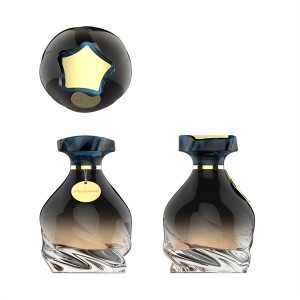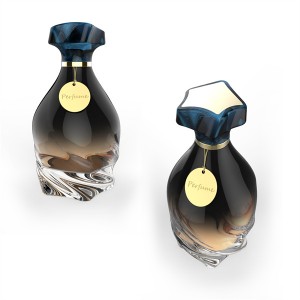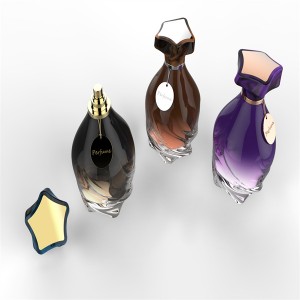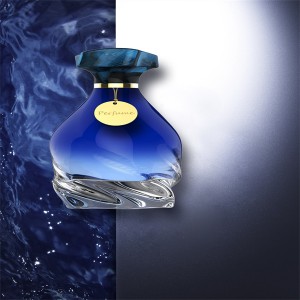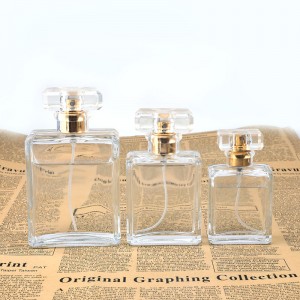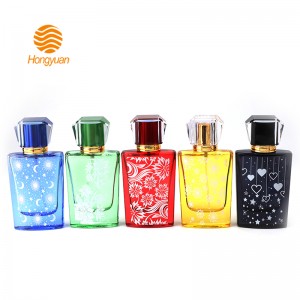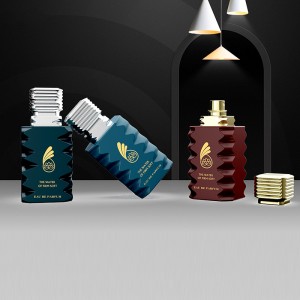Basic Info
Model NO.:L-N007-1 Body Material: Glass
Product Details
Key Specifications/Special Features
| Model number | L-N007-1 |
| product type | perfume glass bottle |
| texture of material | Glass |
| Colors | customized |
| Packaging level | Seperate packing packaging |
| Place of Origin | Jiangsu, China |
| Brand | HongYuan |
| product type | Cosmetic bottles |
| texture of material | Glass |
| Related accessories | Plastic |
| Processing and customization | yes |
| Capacity | 100ml |
| 20ft GP container | 16,000 pieces |
| 40ft GP container | 50.000 pieces |
Product Production
This 100ml bottle, it looks very unique, it is the shape that our designers have calculated with precision, and when you get it, you will find that it is so wonderful. Gradient colors and metallic labels, of course it looks like a necklace of bottles, you can think so too.
1. How are glass bottles made?
The glass bottle production process mainly includes:
① Raw material preprocessing. Crushing the bulk raw materials (quartz sand, soda ash, limestone, feldspar, etc.), drying the wet raw materials, and removing iron from the iron-containing raw materials to ensure the quality of the glass.
②Preparation of ingredients.
③ Melting. The glass batch is heated at a high temperature (1550~1600 degrees) in a pool kiln or pool furnace to form a uniform, bubble-free liquid glass that meets the molding requirements.
④Molding. Put the liquid glass into the mold to make glass products of the required shape, such as flat plates, various utensils, etc.
⑤ heat treatment. Through annealing, quenching and other processes, the stress, phase separation or crystallization inside the glass is eliminated or generated, and the structural state of the glass is changed.
Second, the difference between tempered glass and heat-resistant glass
1. Different uses
Tempered glass is widely used in construction, decoration, automobile manufacturing industry (doors and windows, curtain wall, interior decoration, etc.), furniture manufacturing industry (furniture matching, etc.), home appliance manufacturing industry (TV, oven, air conditioner, refrigerator and other products).
The main applications of heat-resistant glass are in the daily necessities industry (heat-resistant glass crisper, heat-resistant glass tableware, etc.), medical industry (mostly used for medical ampoules, laboratory beakers).
2. The effect of temperature changes is different
Heat-resistant glass is a kind of glass with strong thermal shock resistance (can withstand rapid cooling and rapid heating temperature changes, small thermal expansion coefficient), high temperature (high strain temperature and softening temperature) glass, so in ovens and microwaves, even if the temperature suddenly It is also safe to use when changing.
Tempered glass may be broken after a sudden change in temperature in a microwave oven. During the production of tempered glass, because of the "nickel sulfide" contained in the interior, with the change of time and temperature, the glass expands and has the possibility of self-explosion. Oven completely unusable in .
3. Different ways of crushing
When the heat-resistant glass is broken, cracks are generated and will not be scattered. The heat-resistant glass is not in danger of self-explosion due to nickel sulfide, because the heat-resistant glass gradually cools down, and there is no energy for condensation inside the glass, so it is broken. It won't fly away either.
When the tempered glass is broken, it will shatter and scatter. During the tempering process of the tempered glass, prestress is formed inside the glass and the energy condenses, so when it is broken or self-exploded, the condensed energy will be released, and the fragments will scatter and produce Explosion.


